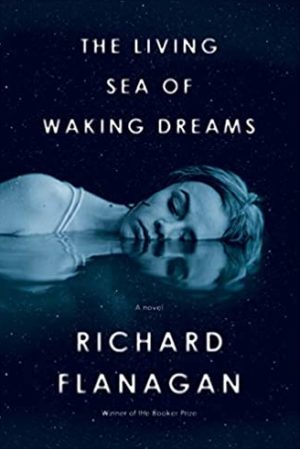The Living Sea of Waking Dreams
by Richard Flanagan
reviewed by Hamilton Cain
Just before COVID-19, Australia was burning to the ground. During the summer of 2019–2020, unprecedented heat and freakish storms sparked massive wildfires that scorched millions of acres from the outback to the coasts. Smoke cloaked the continent. Refugees huddled on beaches. And the indigenous fauna took a devastating hit: images of charred kangaroos circulated on social media, and at least 30,000 koalas perished, with many more maimed.
Against this backdrop the Booker Prize-winning writer Richard Flanagan sets his gorgeous, mesmerizing new novel, The Living Sea of Waking Dreams, connecting Australia’s ecological cataclysm with the anomie of a Tasmanian family, as Francie, the eighty-six-year-old matriarch, drifts toward death in a Hobart hospital. Her eldest child and only daughter, Anna, Flanagan’s middle-aged protagonist, is called back from her architecture firm in Sydney—away from her partner Meg and troubled son, Gus, whom she has raised as a single mother—to her hometown. Her youngest brother, Terzo, a wealthy, possibly corrupt trader, flies in from Brisbane to join Anna and their brother Tommy, a flailing artist with a stutter and a child with schizophrenia, who has remained in Hobart as Francie’s caretaker even though he can barely take care of himself. The three siblings, as well as the infirm Francie, all orbit an emotional black hole: the death of their brother, the golden boy Ronnie, who mysteriously hanged himself at fourteen.
Reading Flanagan is like watching Federer at Wimbledon: he can do pretty much anything on the page and make it look easy, elegant. One of the novel’s many marvels is how Flanagan persuasively depicts Francie seesawing between flatlining to recovery and back again. Anna and Terzo leave only to turn back to Hobart, summoned by Tommy’s frantic texts. In lucid moments, Francie drones on about magical creatures—animals morphing into plants, one-eyed CIA agents, a witch—outside her hospital window. She sees things that aren’t there. Then Anna notices that parts of her own body have disappeared, painlessly, leaving a pixelated blur—first a finger, then a knee. And she’s not the only one gradually being erased.
Erasure is a running theme in The Living Sea of Waking Dreams: missing digits, a beloved teenager long dead, eroded relationships, an imaginary world, the real one going up in flames. Flanagan refigures his characters, literally, just as our species has refigured the planet. Anna is living through her own Anthropocene, escaping, as most of us do, through apps on her phone: “What is the image for nothing? Where is a language she thought she didn’t she tried Insta again it loaded. So much joy! Instagram, blessed Novocaine of the soul!”
As Flanagan suggests, technology distracts us from our own frailty. Smug in their urbane success, Anna and Terzo fall into the habit of harassing Tommy, who has never recovered from his brother’s suicide. Screen time only exacerbates their cruelty: “Terzo was in such a good mood, thought Anna, that not even Tommy, or Tommy’s cooking, could annoy him. And still he kept scrolling down, as if his finger were a cat’s paw playing with a doomed songbird.”
So much is going on in this novel, yet Flanagan never misses a beat. His language is drum-tight, his ear for prose rhythms impeccable, whether he slips into the stream of Anna’s social media or throwing in a dash of ironic humor, as in Anna’s observation: “But now [that her knee] had vanished she realised she missed it. But like the aurochs it was gone. Like the thylacine and the Walkman. Like long sentences.” Right on cue, Flanagan’s long sentences pick up again.
From his first book, Death of a River Guide, Flanagan has written epics that speak not only to his continent but also to broader historical change. Anna battles through her myriad crises even as her phone fails her:
She opened Twitter which she thought she could endure. Photos of ember blizzards. Smoke so thick you couldn’t see across a road. Four thousand people with no way gathered on a beach with the firefighters forming a cordon around to protect them … When the fire trucks sounded their sirens everyone was to get under water. This land so vast, its people driven into the sea. When the red glow came was that all they would have left?
Death broods over this novel; the reader senses Flanagan’s eye on the clock, his preoccupation with his own mortality. And yet the mosaic of life endures—fitful, imperiled, but also joyous. Transformations are everywhere in The Living Sea of Waking Dreams. Flanagan saves his most intriguing reveals for the later chapters, as Anna, pilgrim-like, seeks the celestial city of home. In a year rich with climate fiction—Imbolo Mbue’s How Beautiful We Were, Jim Shepard’s Phase Six—Flanagan has given us a novel that’s inventive and lyrical, a dark meditation on where we are and where we may be headed. The Living Sea of Waking Dreams is his finest work yet.
Published on July 13, 2021

